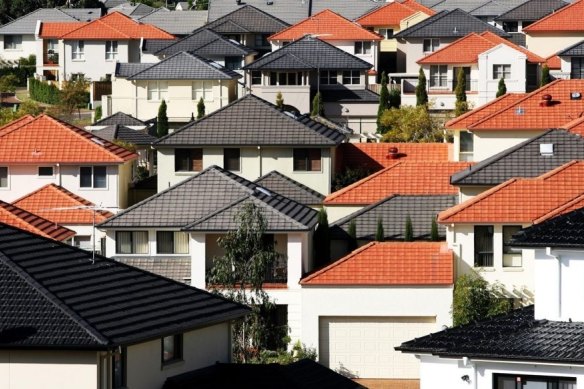
The housing joke is wearing thin for the TikTok generation
Save articles for later
Add articles to your saved list and come back to them any time.
You might have heard ANZ’s chief executive worry last week about banking and access to credit becoming a privilege available only to the well-off. It’s something most young people have known for some time; the surprise was that a big boss took notice and decided to talk about it.
I’ve heard over and over again from some in generations before us that saving for a house isn’t easy, that they had to rent a shoebox apartment for years, too, that they started off in the outer suburbs and that we just need to be patient and work hard.
A smaller proportion of people are securing home loans.Credit: Louie Douvis
But as the population has grown, those outer suburbs have become further and further away, house prices (and living costs more broadly) have continued to rise and the plumbing-problem-prone flat I rent with my friend is looking increasingly like a permanent hermitage.
Dark humour has become a coping mechanism of sorts. Remember the “feed your family for $10” Coles commercial with Curtis Stone? Friends at work recently pointed me to a video making rounds on TikTok showing $10 only bought a bag of cheese. That evening, I walked into Coles and saw that wasn’t a joke. I had to laugh.
But, really, that’s a problem. When wages are rising slower than prices, it’s no surprise that banks aren’t eager to lend to those with lower incomes and savings. The fact that many young people are also saddled with tens of thousands of dollars of tertiary education debt doesn’t help.
ANZ boss Shayne Elliott blames regulation for the banks’ diminishing ability to lend to “risky” borrowers. Tighter lending standards and capital requirements over the years from the Australian Prudential Regulation Authority (APRA), have meant banks are unable to extend credit to those who are less wealthy, he argues, or have to pass on the higher compliance costs to customers.
While those regulations are in place to maintain a safe banking system that doesn’t overextend itself, there is a need to strike the balance between keeping the system strong and making sure responsible customers have the chance to access credit. Australian Banking Association chief executive Anna Bligh says, “with an additional 1175 pages of new laws and regulations on banks in the past four years, it’s probably time for governments and regulators to take a breather for a while.”
Tighter lending standards may not be the full story, but it’s true that a smaller proportion of the population is accessing loans.
The value of new loans for owner-occupiers to buy existing houses grew from about $6 billion in July 2005 to about $12 billion in July 2023 (after spiking in the past few years because of government stimulus measures). But that doubling doesn’t mean more people are getting loans. The average size of these loans grew from about $248,000 in July 2005 to $593,000 in July 2023. About the same number of people are being issued loans as 18 years ago, while the population has grown by about 6 million people in that time, meaning a smaller proportion of people are securing loans.
Increasingly, people who can’t secure loans with traditional banks are turning to non-bank lenders, especially for mortgages. That’s not always a bad thing, but these institutions often provide less favourable terms to borrowers because they’re pricing in the higher risk they’re taking by lending to those that the banks may deem too risky.
Hidden behind the major banks’ surprisingly healthy delinquency rates recently, is the more notable rise in indicators of financial stress among non-bank lenders. With limited options, lower-income customers are being pushed to the fringes where they’re more likely to get into trouble.
APRA is not responsible for regulating non-bank lenders, which is part of what makes non-bank lenders more risky, but its chair John Lonsdale said non-bank lending was an area the regulator kept an eye on to assess broader risks to the system.
“Delinquencies, 30-day arrears, they are kicking up a little bit among major banks but are still very low,” he told media last week. “But that is not the case on the non-bank side where I think you are seeing more stress.”
Non-bank lenders inject more competition into the system, which helps to keep banks on their toes. But if banks are unable to compete in the same space because of excess regulation, that benefit may no longer exist and lead to worse terms for borrowers pushed to the fringes.
The big issue for young people, though, is less with the banking system itself, and more to do with the broader issue of lack of housing supply. If it feels like you’ve heard this a hundred times before, it’s because you have. We’ve been harping on about it for years. But little has been done about the shortage of housing that has continued to drive prices up.
The bank of mum and dad is an option for some, but it’s important that we all get a fair go, regardless of the wealth we were born into.
Zoning laws need to be wound back to allow more density and there should be more incentives, whether through reducing red tape or increasing spending on affordable housing, to build more houses. We have to go hard now because we know how long building takes, and the longer we wait, the harder the problem gets to fix.
While we laugh off our problems now, I suspect the jokes won’t be quite so funny down the line. Let’s not wait to find out.
Millie Muroi is a business reporter at The Sydney Morning Herald.
The Business Briefing newsletter delivers major stories, exclusive coverage and expert opinion. Sign up to get it every weekday morning.
Most Viewed in Business
From our partners
Source: Read Full Article
